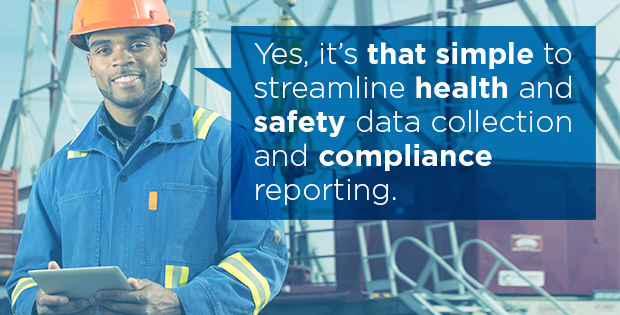 Of all of the mobile business processes in the field and on job sites, there are perhaps no more critical ones than those related to health and safety. Whether it’s a safety inspection or time-sensitive incident reporting, HSE professionals are tasked with safeguarding an organization’s workforce and customers using safety data collection.
Of all of the mobile business processes in the field and on job sites, there are perhaps no more critical ones than those related to health and safety. Whether it’s a safety inspection or time-sensitive incident reporting, HSE professionals are tasked with safeguarding an organization’s workforce and customers using safety data collection.
The pitfalls of HSE reporting and compliance
The traditional pain points of field safety data collection, delivery, and incident reporting are numerous.
- Paper forms take a long time to complete, contain illegible handwriting, incorrect calculations, missed form fields, and are difficult to secure in inclement conditions
- Delivering paper forms back to the office can delay the communication of critical, time-sensitive information, and data entry in the office adds further delays. This means delays in decision-making and opportunity discoveries from incident reporting
- With inefficiency comes unnecessary costs, including paper and printing costs, fuel costs from picking up job orders at the office or transporting completed forms back to the office, data entry labor costs, and more
Conducting HSE processes on mobile devices for incident reporting is the answer
You can overcome the safety data collection/submission/communication challenges of incident reporting with the deployment of mobile solutions like ProntoForms. Indeed, long-time obstacles to streamlining HSE processes and accessing critical data wherever and whenever it’s needed, are becoming a thing of the past.
- Mobile forms speed up safety data collection through pre-filled dropdown options (e.g. customer location). They can ensure that no form fields are missed (e.g. mandatory fields), all entered text is legible, and all calculations are accurate. In addition, since forms are immediately submitted from the App, there is zero chance of them getting lost or damaged in transit
- Collected form information can be submitted in real time to any back-office or cloud service, eliminating transportation or data entry delays. With faster access to field data, organization executives can make important decisions and discover opportunities quicker, streamlining the incident reporting process
The path to compliance is changing with incident reporting software
For many, regulatory and SLA reporting remains a complicated and all-consuming process. Not only must HSE professionals document all safety inspection activities, they also have to extract and format the necessary data to adhere to industry and customer standards. In most cases, the data must also be readily available for audit purposes, leading to a tremendous need to streamline incident reporting.
Fortunately, mobile solutions have enabled organizations to engage in safety data collection faster and integrate it with back-end systems.
Cloud-based business intelligence platforms, such as ProntoForms Analytics, are able to incorporate the collected data into powerful compliance and operations performance reports, capable of meeting regulatory and SLA requirements.
It’s a major step forward in the number-crunching battle that health and safety executives wage every month to conquer their incident reporting taskload.
Digging deeper on tracking and reporting with a safety audit checklist
The advanced capabilities for tracking and reporting that cloud-based business intelligence offers is tailor-made for health and safety data. Analytics captures the mobile data submitted by HSE Inspectors and can store it for years. This data can be analyzed, aggregated, and used to produce reports based on industry based health and safety standards. Key health and safety metrics such as the Total Recordable Incidence Rate (TRIR) or Lost Workday Incidence Rates can be calculated and reported on for a specific year, or as a year-over-year comparison chart, and displayed in online Dashboards accessible by your management team.
Analytics solutions can automate all the steps from safety data collection to reporting and analysis, and deliver scheduled reports to specific email addresses as required (ex. weekly, monthly, yearly). It’s a strategy for incident reporting that gives organizations their best chance at 100 percent compliance.
Mobilizing HSE reporting is an easy internal sell for safety data collection
For organizations that have not yet mobilized health and safety processes, the ROI isn’t difficult to see. The faster data is captured, the faster it can be processed, analyzed, and used to transform the entire outlook of an organization. But at the end of the day, it simply comes down to what keeps a company’s workforce safer.
We’ve seen firsthand how going mobile can take the processing time of a health and safety incident report from days down to an hour or less! Talk about the ability to assess a critical situation right away and take decisive action. If that doesn’t say ROI, I don’t know what does.




